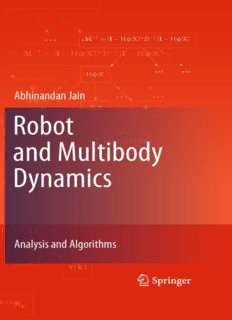
Robot and Multibody Dynamics: Analysis and Algorithms PDF
Preview Robot and Multibody Dynamics: Analysis and Algorithms
Robot and Multibody Dynamics Abhinandan Jain Robot and Multibody Dynamics Analysis and Algorithms 123 AbhinandanJainPh.D. JetPropulsionLaboratory 4800OakGroveDrive Pasadena,California91109 USA abhi.jain@jpl.nasa.gov ISBN978-1-4419-7266-8 e-ISBN978-1-4419-7267-5 DOI10.1007/978-1-4419-7267-5 SpringerNewYorkDordrechtHeidelbergLondon LibraryofCongressControlNumber:2010938443 (cid:2)c SpringerScience+BusinessMedia,LLC2011 Allrightsreserved.Thisworkmaynotbetranslatedorcopiedinwholeorinpartwithoutthewritten permission of the publisher (Springer Science+Business Media, LLC, 233 Spring Street, New York, NY10013, USA),except forbrief excerpts inconnection with reviews orscholarly analysis. Usein connectionwithanyformofinformationstorageandretrieval,electronicadaptation,computersoftware, orbysimilarordissimilarmethodologynowknownorhereafterdevelopedisforbidden. Theuseinthispublicationoftradenames,trademarks,servicemarks,andsimilarterms,eveniftheyare notidentifiedassuch,isnottobetakenasanexpressionofopinionastowhetherornottheyaresubject toproprietaryrights. Printedonacid-freepaper SpringerispartofSpringerScience+BusinessMedia(www.springer.com) In memoryof GuillermoRodriguez, anexceptional scholaranda gentleman. To myparents, and tomywife, Karen. Preface “Itisaprofoundlyerroneoustruism,repeatedbycopybooksandbyeminentpeoplewhen they are making speeches, that we should cultivate thehabit of thinking of what we are doing. The precise opposite is the case. Civilization advances by extending the number ofimportantoperationswhichwecanperformwithoutthinkingaboutthem.Operationsof thoughtarelikecavalrychargesinabattle–theyarestrictlylimitedinnumber,theyrequire freshhorses,andmustonlybemadeatdecisivemoments.” AlfredNorthWhitehead Robotics,anditsneedforreal-timecontrol,hasexpandedresearchinmultibody dynamicsbeyondmodelingandsystematicformulations,tocomputationalandcon- trolissues.Whilesignificantprogresshasbeenmadeintheseareas,themathemat- icalcomplexityofthesystemdynamics,andthepaucityofanalyticalconceptsand mathematicaltoolstomanagethecomplexity,presentimposingchallenges. The body of work known as the spatial operator algebra (SOA) providessuch analyticalandmathematicaltechniquesthataddressthesechallenges.TheSOApro- videsspatialoperatormathematicalconstructs,thatconciselydescribethesystem dynamicsandenabledynamicsanalysisinaunifiedandgeneralsetting. Thattheequationsofmultibodydynamicscanbedescribedbyanalgebraofspa- tialoperatorsiscertainlyofmathematicalinterest.However,theSOAalsoprovides themeanstomanipulateatahighlevelofabstractiontheequationsdescribingmulti- bodybehavior.Thesignificanceofthisgoesbeyondthemathematicsandisuseful inapracticalsense.Atanystageofthemanipulationofequations,spatiallyrecur- sive algorithmsto implement the operator expressionscan be readily obtained by inspection.Therefore,thetransitionfromabstractoperatormathematicstopractical implementationisstraightforward,andoftenrequiresonlyasimplementalexercise. Thefocusofthisbookisonprovidingacomprehensiveandcoherentdescriptionof the SOA methodologyand techniques,and ofthe interplaybetweenmathematical analysis,structuralproperties,andcomputationalalgorithms. Thematerialinthisbookservesasapointofdepartureforfurtherexplorationof topicsinmultibodydynamics.Thus,whilethetextiswritteninastylethatisacces- sible to a newcomer,it wouldbe bestappreciatedby practitionersandresearchers inthefield. vii viii Preface Thebookisorganizedintothreeparts.Part1,consistingofChaps.1–7,isastudy ofthedynamicsofrigid-link,serial-chainsystems.Thesearethesimplestexamples of multi-linksystems. Theyserve to introducethe notionof spatialoperators,and to developthe conceptsof mappingoperatorexpressionsinto low-ordercomputa- tionalalgorithms.InPart2,consistingofChaps.8–13,theoperatortechniquesare generalizedtoincludethebroaderclassofmultibodysystems.Graphtheoryideas areusedtodescribethestructureoftheoperatorsatalevelofabstractionthatmakes themindependentofthesize, thetopologicalstructure,andthedetailedproperties of the linkages. Part 3 is an exploration of the application of SOA techniques to advancedtopics.Theseincludemethodsforpartitioningandsub-structuringmulti- bodymodels,constraintembeddingfortransformingclosed-chainsystemsintotree systems,thedynamicsofunder-actuatedsystemsandfree-flyingsystems,derivation ofanalyticalsensitivityexpressions,anddiagonalizeddynamicsformulations. The text is interspersed with exercises that further explore a topic or present a related idea. All solutions are provided at the end of the book. Key results are summarizedinlemmaswithself-containedassumptionsandconclusions. Rarelyisthereasingleapproachorsolutionthatworksforthevarietyofprob- lems encounteredwhen workingwith robotand multibodysystem dynamics. The emphasis of this book therefore is on deepeningthe theoretical and mathematical understandingof the operatortools, and on the rich tapestry of inter-relationships amongthem.Asingletopicisthussometimesexploredfromdifferentangles,and themesandconceptscuttingacrossdifferentcontextsarehighlighted. Acknowledgments My introduction to the fields of robotics and multibody dynamics began when IjoinedtheJetPropulsionLaboratory(JPL).GuillermoRodriguezhadrecentlydis- coveredtherichparallelsbetweenthemathematicaltheoryunderlyingoptimalfil- teringandestimationtheory,andthestructureofthedynamicalpropertiesofrobotic systemsthatformedthebasisoftheSOA.Ihadthegoodfortuneofjoininginthis pioneering research. and, until his untimely passing, had the incredible personal experienceofcollaboratingandworkingwithGuillermo. Overtheyears,Ihavebenefitedinnosmallmeasurefromthecontinuousinter- actionsandsupportfrommanyexceptionalcolleaguesatJPL.KenKreutz-Delgado introducedmetotheearlydevelopmentsoftheSOA methodology.GuyMan’svi- sion helped initiate the “real-world” application of the SOA techniques to solve challengingdynamicsmodelingproblemsforNASA’sspacemissions.Iamgrateful tomycolleaguesatJPL’sDARTSLab,includingBobBalaram,JonathanCameron, Christopher Lim, Marc Pomerantz, Hari Nayar, Jeff Biesiadecki and many others whohavecontinuedtoadvancethemethodologyandmakepossibleitsapplication tochallengesinspacerobotics.IthasalsobeenapleasuretoworkwithNagarajan Vaidehiin the non-engineeringapplicationof the SOA ideas to the moleculardy- namicsarena.I wouldliketo thankJohnWen andRich Volpefortheir persuasive Preface ix encouragementtoworkonandtopublishthisbook.Last,butnotleast,Iwouldlike to thank my family, Karen, Aarti, and Nikhil, who valiantly helped with figures, proof-reading,andstylisticsuggestionsforthetext,andfortheirincrediblepatience andforbearancethroughthemonthsofitspreparation.
Description: